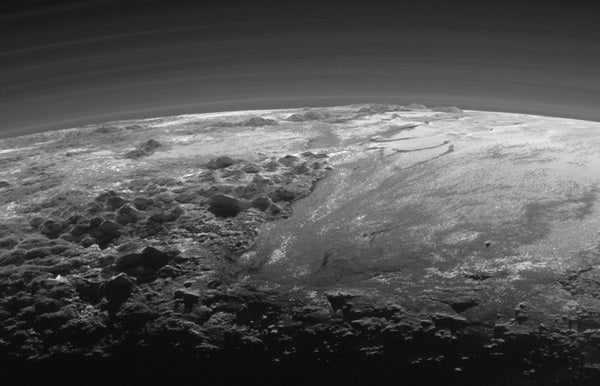Once, we thought earth was the only planet with oceans. But now, we’re seemingly finding them everywhere in our solar system, including possibly the last place on anybody’s mind: Pluto.
New evidence published in Geophysical Research Letters shows that the icy dwarf planet may still have a liquid ocean lurking underneath its frozen exterior. Tectonic activity on the surface of Pluto, revealed by NASA’s New Horizons spacecraft, shows an absence of contraction in the surface. Contraction is the kind of thing that would be expected if the ocean had, at the depths it’s believed to be at, frozen completely into a dense form of ice called Ice II. That seems to indicate it’s liquid or at least slushy down there.
Radioactive elements in the core (along with some motion from the tug-o-war between Pluto and Charon) would keep the ocean warm. There’s still some chance, though, that the ice crust of Pluto is thinner than anticipated, which would lead to formation of less dense forms of ice. But flows of nitrogen ices seem to come from much deeper below, placing the ice shell as much as 300 km (186 mi) from the surface. At those depths, if there was water, it would almost certainly form Ice II. That is, unless something made it not freeze.
Of course, we already know that Enceladus, a moon of Saturn, is an ocean world, with warm water under the ice shell spewing into space thanks to the gravitational tug of Saturn. Pluto joins that pantheon now, along with worlds like Ganymede, Europa, and Titan. But unlike Pluto, new evidence seems to indicate that Enceladus may have a much thinner ice shell than once believed.
The research, also published in Geophysical Research Letters, suggests that the crust at the south pole of Enceladus may be as little as 3 km (1.86 mi) deep. That would also make drilling under the ice shell a more distinct possibility for a future space probe, or to have an orbiter penetrate the ice shell with radar to find out more of what’s going on down below. Previous measurements of the ice shell, which placed it as much, much thicker, didn’t line up with gravitational data collected by the Cassini probe.
It’s a lot of excitement for two small places in our solar system. Many astrobiologists already think Enceladus may be a high probability place to find life. But now that Pluto is on the radar, we’re seeing that liquid water is even more abundant than we thought. On Earth, where there’s water there’s life. And now we have to recognize that there might be a chance for life on Pluto.










